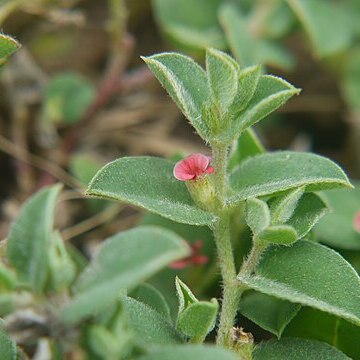Herbs, procumbent or ascending, 10-30 cm tall. Stems with appressed to slightly spreading white symmetrically to slightly asymmetrically 2-branched trichomes. Stipules lanceolate, ca. 2 mm, with spreading subbasifixed extremely asymmetrically 2-branched trichomes, apex cuspidate. Leaves simple; petiole ca. 1 mm; leaf blade oblong to cordate, 4-8 × 3-6 mm, abaxially with dense long spreading subsymmetrically to symmetrically 2-branched trichomes, adaxially with long spreading white subbasifixed trichomes, secondary veins not visible, base cordate, apex acute and with a ca. 0.2 mm mucro. Racemes 2-3 mm, 1-4-flowered; bracts narrowly triangular, ca. 2 × 0.5 mm, apex cuspidate. Pedicel 0-0.5 mm. Calyx with dense spreading white subbasifixed long trichomes; tube ca. 0.5 mm; teeth linear-triangular, 1.5-2 mm. Corolla standard spatulate to cuneate, 2.5-3 × 1-1.5 mm, outside hairy at apex, apex obtuse; wings ca. 2.5 × 0.2 mm, glabrous; keel ca. 2.5 × 0.5 mm, glabrous, lateral spur ca. 0.3 mm. Stamens 2-2.5 mm; anthers ca. 0.2 × 0.3 mm, glabrous. Ovary with spreading white long trichomes, with (1 or)2 ovules. Legume ellipsoid to subglobose, 2.5-3 × ca. 1.6 mm, with densely subspreading white trichomes. Seeds (1 or)2 per legume, reddish brown. Fl. Oct-Nov, fr. Nov-Dec. 2n = 16.
A herb. It grows from seeds each year. It lies along the ground and is branched. It grows 30 cm high. The leaves are simple. They are 6-16 mm long and 4-13 mm wide. They are broadly oval and hairy on both sides. There are 4-8 flowers in a head. They are red. The fruit is a pod 4-5 mm long. It is densely hairy. There are 2 seeds.

